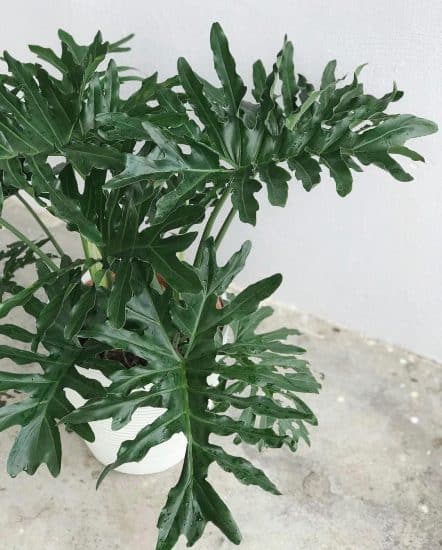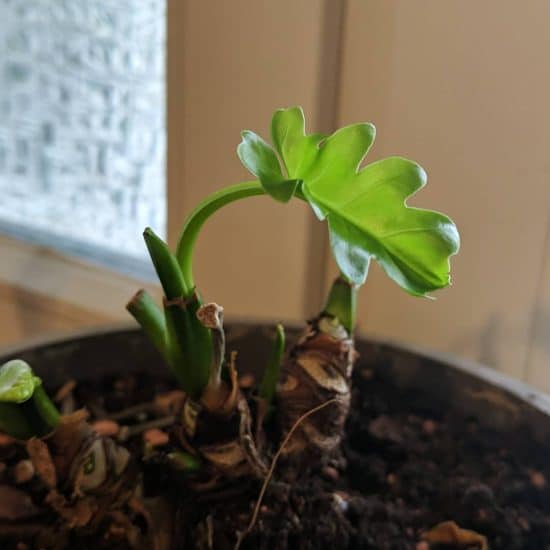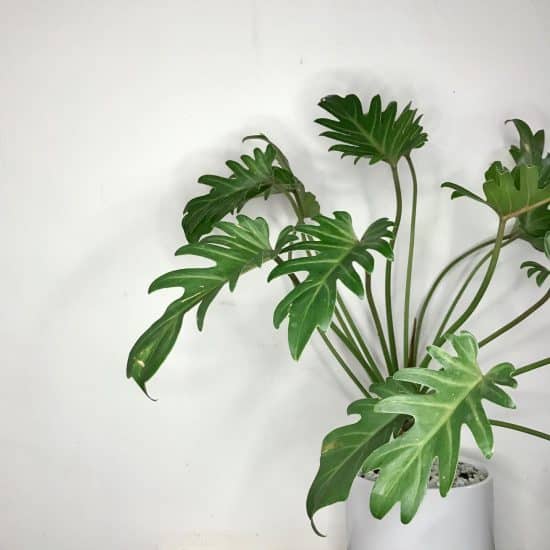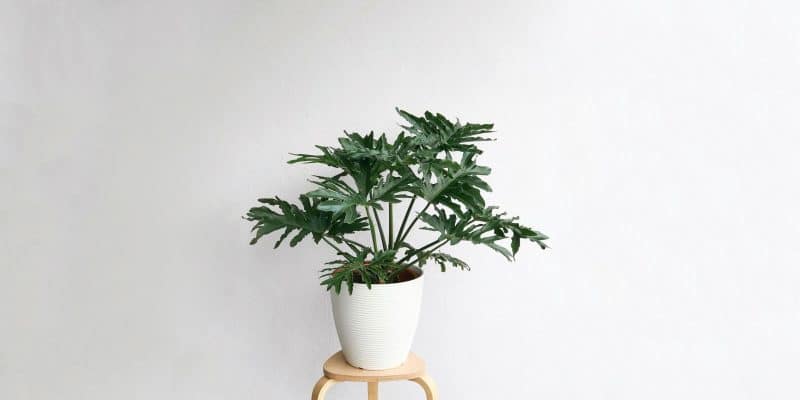Time to shine a light on Thaumatophyllum Xanadu, a tropical plant with lush green foliage and leaves that are deeply divided along the edges. It recently had a name change, so we’ll refer to it by Philodendron Xanadu interchangeably as well.
Despite a dual name status that might give off intimidating vibes, this plant is a fast grower that’s super easy to maintain (and propagate for friends!).
We’ll cover everything you need to know about Philodendron Xanadu care (including the mysterious name change!) so you can give this fabulous plant the love it deserves.
Table of Contents
Thaumatophyllum Xanadu Plant Care Guide
History, Habitat, and Characteristics

So, what’s the scoop on Thaumatophyllum Xanadu? Formerly considered a Philodendron (a related genus in the same plant family, Araceae), this little gem was reclassified in 2018 as a species of Thaumatophyllum based on DNA evidence.
This perennial plant stands out with its deeply lobed leaves that spread out like open hands. These fast growers can become large houseplants, up to 3 feet tall and 5 feet wide grown indoors (and even bigger outside with the help of their large aerial roots). What’s more, as the older Philodendron Xanadu leaves fall off, they leave behind eye-like scars that give the trunk a dramatic appearance.
Fun tidbit: Until it was discovered growing as a wild species in Brazil, this tropical plant was thought to be a cultivar originating from a nursery in Australia. It was given the cultivar name of Philodendron Xanadu ‘Winterbourn’ or Winterbourn Philodendron — a moniker that it’s still commonly called by around the globe.
Light

In its native habitat, Philodendron Xanadu is a subshrub that thrives in filtered light. Philodendron Xanadu light requirements aren’t different indoors. You can mimic the ideal light conditions for this tropical plant by placing it in a spot that gets bright, indirect sunlight. A south-facing window with blinds to filter the mid-day sun is an ideal set-up.
If your Xanadu plant isn’t getting enough light, you’ll notice its growth slowing down, and the leaves might become leggy or start to wilt. In this case, you can either move the plant to a brighter window or introduce a full-spectrum LED grow light to give it the extra boost it needs.
On the flip side, too much sunlight can cause Philodendron Xanadu leaves to scorch, change color, or develop small holes. If you notice any of these signs, move your Xanadu to a spot with softer sunlight or use a sheer curtain to filter the light coming through the window.
Lighting tips:
- Place your Philodendron Xanadu near a south-facing window with blinds for optimal bright light without direct sun exposure.
- Shield your plant from intense sunlight to prevent scorching, browning, and holes from developing in the leaves.
- Boost lighting conditions by moving your Philodendron Xanadu plant to a brighter spot or use a full-spectrum LED grow light.
- Regularly check your plant for signs of light stress and make necessary adjustments to keep your Xanadu healthy and vibrant.
Water

Philodendron Xanadu watering is pretty straightforward — this plant likes moist soil that’s allowed to dry out a bit between waterings. If you’re wondering about when to water your Xanadu, gently poke a chopstick or your finger two or three inches into the soil. If the soil surface is dry when you pull it up, it’s time to quench your plant’s thirst.
If you see the oldest leaves (those at the base of the plant) turning yellow or brown and wilting, it likely means that your Philodendron Xanadu is not getting enough water. The leaves might also curl up when they’re thirsty. In this case, water your plant more frequently and remove any dying leaves so that it will put its energy into new, healthy growth.
On the other hand, yellowing leaves, white spots, mushy stems, and lingering moisture in the soil are clear indicators of overwatering. If you’re facing this issue, take a step back and reduce your watering frequency. Give the soil some time to dry out between each hydration session. If necessary, repot your Philodendron Xanadu using fresh soil that has better drainage (no root rot allowed here!).
Temperature and Humidity

Philodendron Xanadu grow well if you can replicate a somewhat ‘tropical’ atmosphere.
Aim for warm temperatures between 65-80°F. Be mindful of cold drafts during winter and avoid placing your plant near frequently opened windows or doors, as sudden drops in temperature can cause stress to the plant.
Philodendron Xanadu appreciates a moderately humid environment, ideally between 40-60%. Keep an eye on its leaves; if they begin to curl, turn brown, or droop, it could indicate that the humidity is too low.
On the other hand, if the leaves turn yellow or have signs of mold, the humidity might be too high. This can lead to bacterial or fungal disease, so it’s essential to make quick adjustments if you suspect the environment is too humid.
Humidity tips:
- Use a humidifier to increase indoor humidity or place your plant on a tray filled with pebbles and water.
- Ensure proper air circulation around your Xanadu to prevent issues related to high humidity.
Soil and Planting

Philodendron Xanadu grows happily in a well-draining soil that’s slightly acidic (pH around 6.0-6.5).
Our recommended soil mix includes:
- 50% high-quality potting soil as a base
- 30% perlite or pumice to improve drainage
- 20% peat moss, coco coir, or other organic matter for moisture retention
If your Philodendron Xanadu soil doesn’t suit its needs, it can display signs of stress such as wilting, yellowing leaves, and stunted growth. Poor drainage can lead to root rot, whereas a mix that dries out too quickly can cause dehydration.
To avoid these issues, ensure your potting mix has the right combination of ingredients for optimal drainage and moisture retention. Monitoring the moisture level and adjusting your watering routine can also help prevent problems related to the potting mix.
The Philodendron Xanadu plant generally needs repotting every two to three years, with early spring being the best time for this task. Choose a pot that is only one or two inches larger than the current one, and ensure it has drainage holes. Handle the roots gently when repotting, use fresh soil, and avoid packing it too tightly around the root ball, as this can inhibit oxygen flow.
Fertilizer
Philodendron Xanadu fertilizer should be applied during the active growing season (usually in spring and summer, but really whenever you notice new growth on your plant). Use a balanced liquid houseplant fertilizer (such as a 10-10-10 blend) diluted to half strength, being sure to follow the product’s dilution instructions.
Keep an eye out for over-fertilizing symptoms like leaf burn, browning leaf tips, and overall decline in the plant’s health. If you notice signs of over-fertilization, flush the soil with water to remove excess nutrients and reduce your fertilizing frequency.
Propagation

We’ll cover two simple methods to help you propagate your Thaumatophyllum Xanadu (or Philodendron Xanadu, take your pick!), offshoots and division. You can also use stem cuttings.
Propagate Thaumatophyllum Xanadu via offshoots:
- Play the waiting game. Keep a keen eye on your mother plant as it’ll naturally produce offshoots near its base. These little babies are your ticket to more awesome plants!
- Proceed with caution. Armed with a sterilized knife or gardening shears, gently separate an offshoot from the main plant. Remember, it’s a delicate operation, so try not to hurt the roots of either party involved.
- Give baby Xanadu a new home. Grab a pot with drainage holes and fill it with a well-draining potting mix. Plant the offshoot into this new pot, tuck its roots snugly into the soil, give it a good drink of water, and place it in a spot with bright, indirect light.
Propagate Philodendron Xanadu via division:
- Gently extract the plant. Carefully take your Xanadu out of its current pot, doing your best to keep its root system intact.
- Divide and rule. Using a sterilized knife or gardening shears, split off a section with a fair share of roots and leaves.
- Pot the division separately. Pick a pot with drainage holes and fill it with a well-draining potting mix. Bury the roots in the mix. Water your newbie generously and put it in a bright spot with indirect light.
Common Issues

Leaf Drop
Shedding is natural for many plants, including your lovely Philodendron Xanadu. But if you notice excessive leaf drop, it could be due to overwatering, underwatering, or even not enough light.
First things first, check that you don’t have consistently dry or soggy soil. Based on your findings, adjust your watering habits to provide your plant with moist soil that’s allowed to dry out a little between waterings. If watering isn’t the issue, try boosting the lighting with a grow light, or move your Philodendron Xanadu plant to a brighter spot.
Crispy Leaf Tips
Burnt tips usually happen when your plant is getting too much light or not enough water.
First, make sure your Philodendron Xanadu is being shielded from direct sunlight. If those lush leaves are getting sunburnt, protect them with a sheer curtain or move the plant to a spot with less intense light.
When it comes to watering, make sure your plant isn’t parched or drowning; consistently moist soil is the sweet spot here. Keep an eye on these factors, and those leaf tips should start looking as good as new!
Pests and Diseases

Aphids
Philodendron Xanadu pests are common household ones like spider mites and aphids. The latter are tiny, soft-bodied insects love hanging out on the underside of leaves, feasting on the sap from the plant, which leads to leaves curling and turning yellow. They also leave behind something called honeydew, which can cause sooty mold to grow.
To spot this problem, keep an eye out for small, egg-shaped insects gathering together on your plant’s leaves and stems. If you see sticky residue or black sooty stuff, you might have aphids.
In the case of small infestations, you can simply wipe your Philodendron Xanadu leaves with a damp cloth or use a soft brush to remove these pests. If you have a bigger invasion on your hands, whip out some insecticidal soap or neem oil, and make sure to follow the directions on the label.
Check your Philodendron Xanadu house plants regularly for any unwanted guests and nip any issues in the bud. You can also be proactive by providing proper care for your plant, which will not only help to keep it healthy but make it less attractive to pests.
Leaf Spots
Brown, yellow, or black leaf spots on Philodendron Xanadu are usually due to fungi which thrive in damp, humid conditions. These spots are usually irregularly shaped and typically surrounded by a yellow halo. They may start small and expand in size, potentially causing the leaves to drop.
First off, remove any affected black or brown leaves and make sure to dispose of them properly — you don’t want those fungi spreading! Then, treat your plant with a fungicide or neem oil (just follow the label instructions).
Prevent Philodendron Xanadu diseases and fungal issues by using well-draining soil and letting the top two or three inches of soil dry out between waterings. Ensuring good air circulation around your plant will also help to keep moisture-loving fungi at bay. Regularly inspect your Philodendron Xanadu for leaf spots and any other symptoms of disease and treat it early to prevent any serious damage.
Conclusion

That’s a wrap for our Philodendron Xanadu care guide!
Philodendron Xanadu care summary:
- This exotic beauty flourishes in bright, indirect light, and enjoys a well-draining, slightly acidic soil mix. Provide room temperatures between 65-80°F and a humidity level of 40-60% for optimum growth.
- Keep an eye on your Philodendron Xanadu’s water needs, ensuring the topsoil is dry before giving it a thorough watering.
- Fertilize your Philodendron Xanadu during its active growth periods, typically in spring and summer, with a balanced liquid houseplant fertilizer, diluted to half strength.
- Propagate this stunning plant with ease via offshoot separation or division and watch your collection grow.
We hope this guide has armed you with everything you need to know to care for your Philodendron Xanadu. If you found this guide helpful, consider sharing it with friends or fellow plant lovers. And, as always, feel free to reach out if you have questions or concerns.
Best of luck with your Philodendron Xanadu, and happy gardening!
FAQ
Why is the Xanadu plant no longer considered Philodendron Xanadu?
Ah, the curious case of the reclassification! Thaumatophyllum Xanadu used to be considered a Philodendron, but in 2018, it went through a botanical identity change. The reason? Based on DNA analysis, scientists discovered it had more in common with plants in the genus Thaumatophyllum.
Originally thought to be a cultivar, the fact that this plant was later discovered growing as a wild plant species also played into its name change.
Is Thaumatophyllum Xanadu an outdoor or indoor plant?
While it naturally thrives in South American rainforests, Philodendron Xanadu is popularly grown indoors around the world. It can also be grown as a landscape plant under humid and warm conditions. So, whether you want to channel that lush rainforest vibe outdoors or create a cozy atmosphere indoors, this plant can do both.
Is Philodendron Xanadu toxic?
Philodendron Xanadu is toxic to humans and animals, since it produces calcium oxalate crystals that can cause skin irritation.


